The Budgerigar, often called the Budgie, holds the distinction of being the world’s most popular pet bird, trailing only dogs and cats in popularity. These delightful birds are cherished not just for their striking colors but also for their affectionate and loving nature.
If you’ve ever been drawn to the diverse appearances of Budgies, also known as Parakeets in some regions, you’ll be amazed to learn just how many different types exist.
Join us on a journey to explore the world of these iconic birds and discover the captivating variety of Budgie types available.
Budgie Basic Characteristics
Let’s start with the basics about Budgies, some of the most beginner-friendly parrots to care for. In the wild, they munch on seeds, but in captivity, they thrive on a diet of pellets and fresh fruit. These petite birds typically measure around 7 inches in length and weigh just a little over 1 ounce.
They’re known for their friendly, sociable nature and love to engage with their owners, singing cheerful songs to brighten your day. If you’re considering a pet, Budgies make wonderful companions, with a lifespan of 5 to 8 years, often benefiting from being kept in pairs.
Their distinctive wing and head colorations vary, with numerous characteristics and patterns to explore. While there are even more types of Budgie characteristics and color variations, we’ll start with the basics to help you understand the more complex morph types.
Different Types of Budgies
While there is only one species of budgie, the world of budgie enthusiasts is graced with a multitude of color morphs. The exact count of these variants can vary depending on the classification used by different breeding organizations, but there are certainly more than a dozen officially recognized ones.
Among these, a commonly accepted list comprises 13 distinct variants. These categorizations are often based on factors like color, patterns, markings, or unique mutations. Each of these variants adds to the vibrant tapestry of budgerigars, further enhancing their global appeal as cherished pets.
Discover the stunning diversity of Budgerigar color morphs, patterns, and markings with these 13 captivating types of Budgies.
1. Sky Blue Budgie

Sky blue budgies are a light blue color, similar to the color of the sky. They don’t have any dark shades in their feathers. These budgies look green without their yellow pigment, leaving them with a light blue color. They have purple spots on their cheeks and dark blue tail feathers.
Genetically, sky-blue budgies are close to light green budgies. They could have light green parents because their light feather color is a less common trait.
These budgies have a bright blue chest and belly, a black tail and back with white stripes, and a mostly white head with some blue dots. Their beaks are yellow. The sky blue color is a natural, light aqua or turquoise shade for budgies, named for its similarity to the bright blue of the sky.
2. Cobalt Budgie
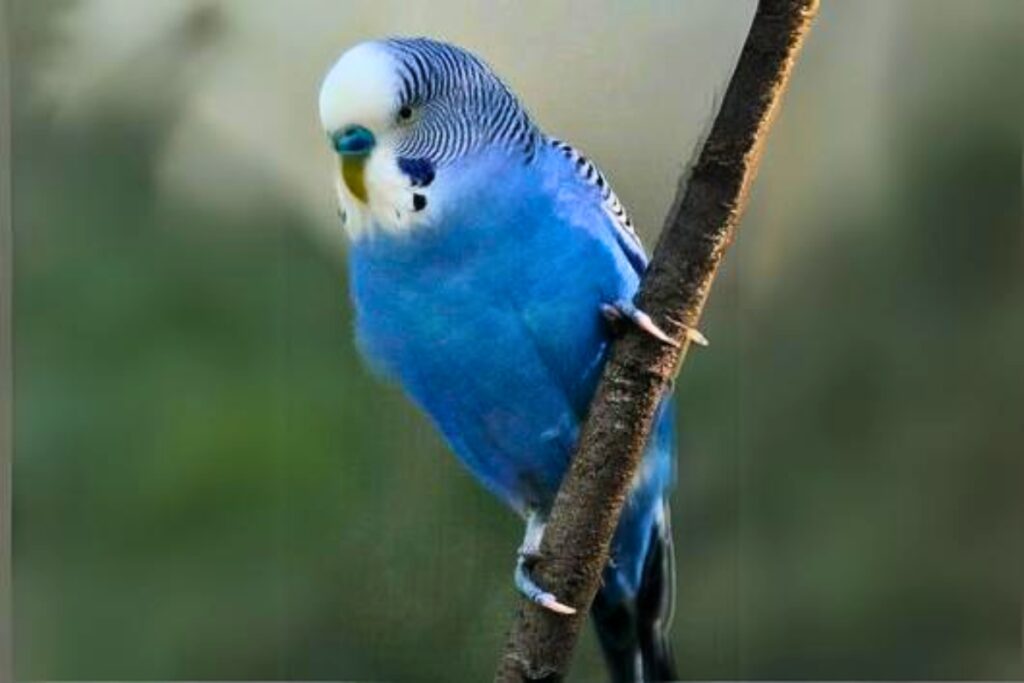
Cobalt budgies have a gene that makes their feathers darker. Sky blue budgies are a lighter blue, while cobalt ones are much darker, almost like a periwinkle color. Both have white heads and backs with black and white stripes.
The cobalt variety of budgies happens when they have one dark factor. This makes their normal sky-blue color a bit darker. Their cheeks are bright purple, and their tails are dark blue.
3. Mauve Budgie

Mauve budgies are the darkest blue color and have two dark factors. Although they have more dark factors than cobalt budgies, they don’t look much darker. Instead, they have a grayish color with a hint of purple.
You can distinguish mauve budgies from gray ones by looking at their cheeks. Mauve budgies still have bright purple cheeks and dark blue tails, like other blue variations.
4. Gray Budgie
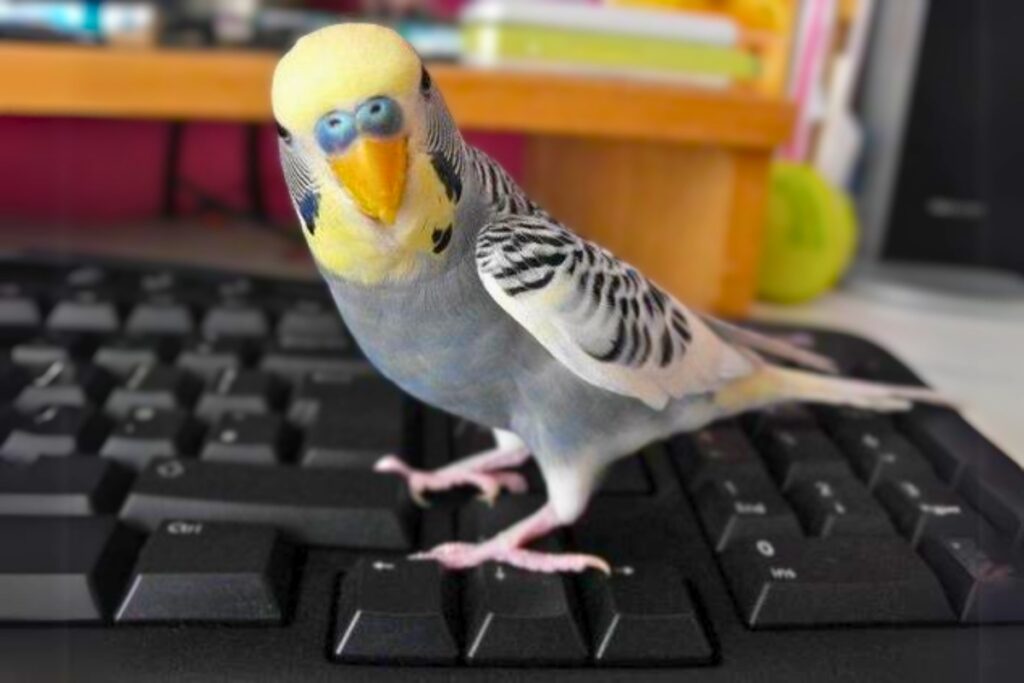
A gray budgie is a blue series budgie with an added gray factor gene. This variation loses the blue tint and has a mostly gray body. Their faces still have cheek patches, but these are now blue, gray, or bluish-gray, and their tail feathers are black.
Gray budgies come in light, medium, and dark shades, just like the blue ones.
5. Violet Budgie

The violet budgie is a unique combination of genes. It looks like a cobalt budgie, but its chest is more of a true purple color, making it one of the few real purples in the budgie color spectrum. The violet color comes from a gene that deepens the budgie’s main body color.
Both blue and green budgies can have this violet gene, but it looks most striking in blue budgies. In some cases, this can result in very deep violet shades, known as visual violet.
6. White Budgie
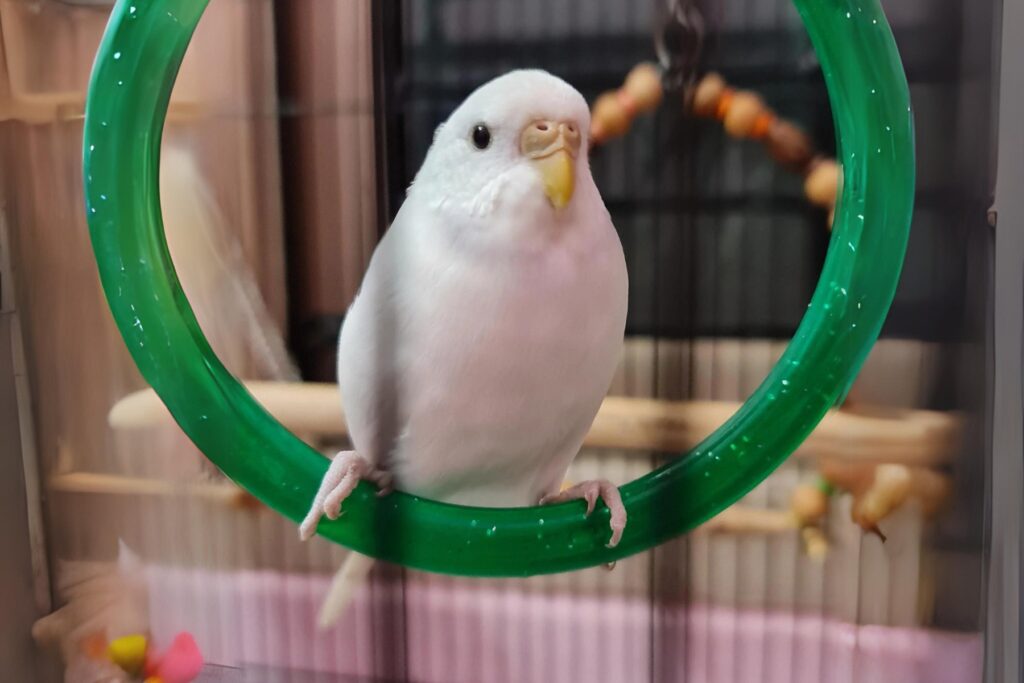
White budgies are, just as the name suggests, all white. They might have small amounts of other colors as accents, but it’s also common to find pure white budgies with no additional colors.
7. Albino Budgie

Albino budgies are completely white because they lack all pigment. Even though they can have dark factors, these don’t show up in their appearance. Albinism is caused by a mutation in the DNA that controls pigment in feathers, skin, or scales. Albino budgies get this recessive gene from both parents, making them white-based.
The way this gene is inherited depends on whether the parents are albino or just carry the gene without showing it. This inheritance is influenced by the sex of the budgies.
8. Light Green Budgie
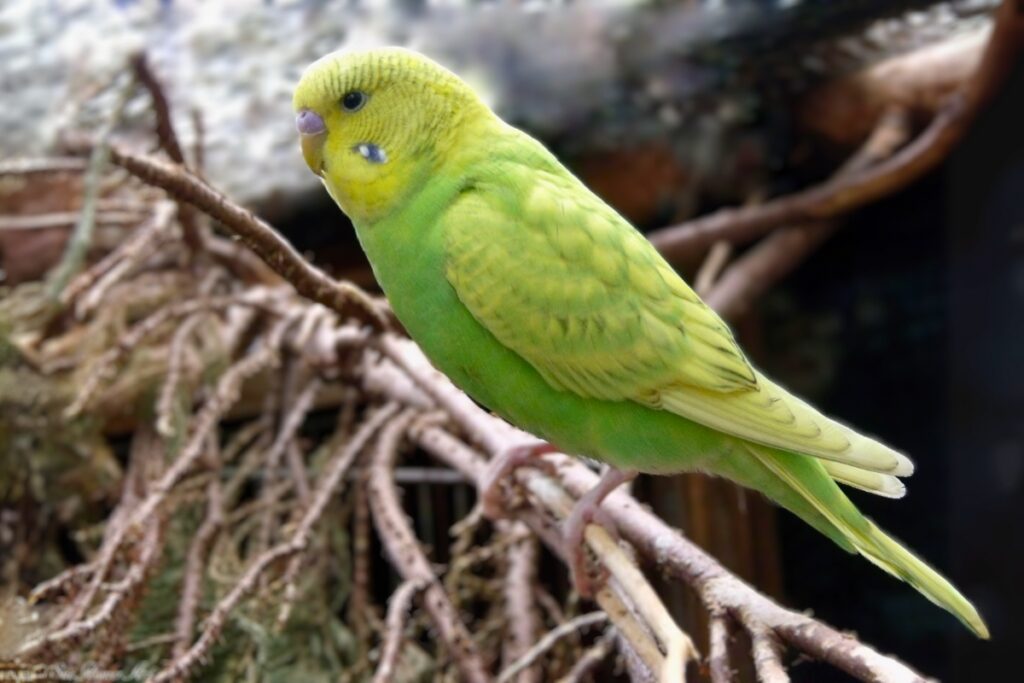
The traditional color pattern of a budgie is bright light green, which is its natural color. This brightness is due to the lack of dark factors in their genes. Underneath this, they have blue and yellow factors that combine to make green. This original color has led to many different variations through selective breeding.
Light green is the foundational color of budgies. Light green budgies have a light green belly and underside, with a yellow head and neck. Their back and wings are dark black, striped with white or yellow that matches their head and neck. They also have dots of pigment around their neck and mouth.
Light green budgies show dominant traits. They are yellow-based, meaning their feathers include yellow. This is different from white-based budgies, which are recessive and typically blue.
9. Dark Green Budgie
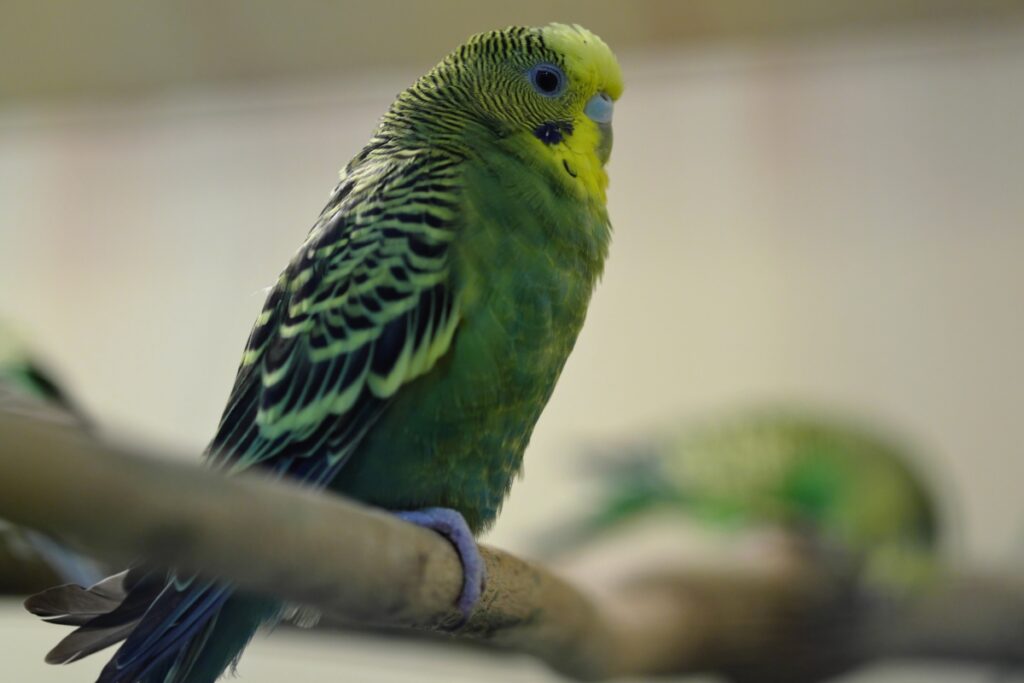
Dark green budgies have one dark factor in their genetics, which makes their green color deeper and less bright than light green budgies. They still have violet cheek patches and dark blue tail feathers. This color change is due to the ‘factor’ system in budgie genetics: with no dark factors, a budgie is light green, but with one dark factor, it becomes dark green.
The chest and belly of a dark green budgie are more vivid and slightly darker, giving a muted and toned-down look compared to budgies with fewer dark factors. However, the head of a dark green budgie remains yellow.
10. Olive Budgie
Olive budgies are named for their color, which resembles olive green. This is the darkest shade of green found in budgies, occurring when they have two dark factors. Unlike other green budgies that usually have a smooth, even green color, olive budgies often appear more splotchy. Like other budgies, they have purple patches on their cheeks and dark blue tail feathers.
11. Gray Green Budgie
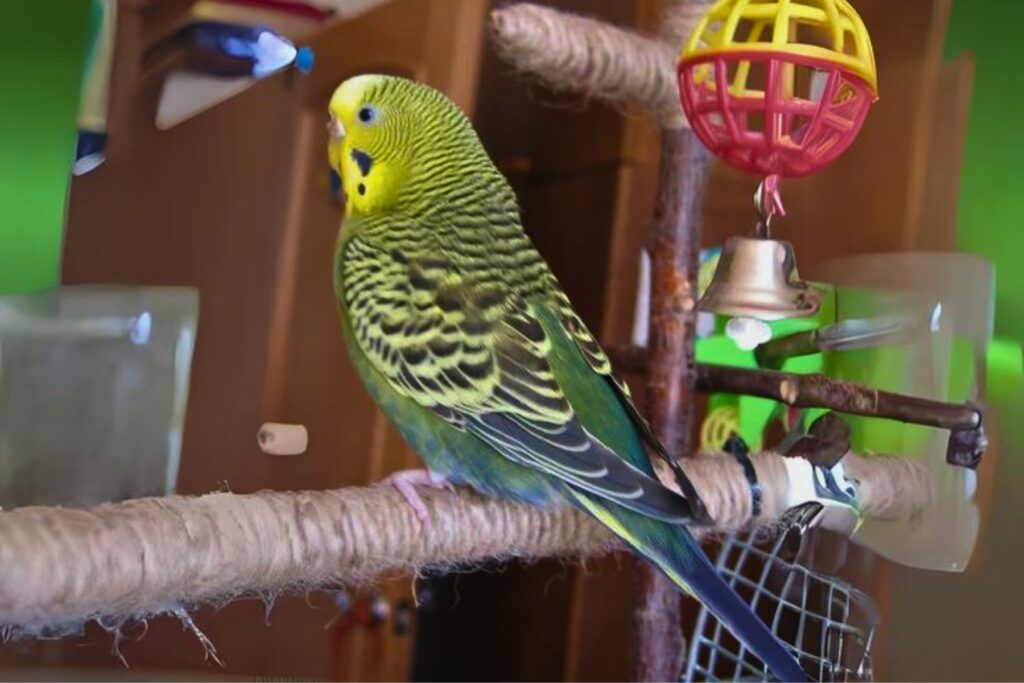
Gray-green budgies are similar to olive budgies but with key differences in their cheek and tail colors. Gray-green budgies have gray/blue cheeks and black tail feathers. This variation comes from a green series budgie with an added gray factor gene.
While olive-green budgies have two dark factor genes, making them very dark, gray-green budgies are slightly brighter than olive greens.
12. Yellow Budgie

Yellow budgies are distinct in their appearance. They can be entirely yellow without any other colors, or they might be mostly yellow with bright green patches on their undersides.
13. Lutino Budgie

Lutino budgies are a yellow-based variation of albino budgies. They are primarily yellow with white or silver cheek patches. Think of them as albino budgies but with a yellow tint. These budgies have light yellow feathers and red eyes.
Lutinos do not have varying patterns or color changes. They can sometimes show additional traits like cinnamon coloration or a yellowface. Predicting the traits of lutino chicks can be challenging because the lutino gene’s expression depends on the sex and appearance of the parents.
To produce female lutino chicks, the father must carry the lutino gene. For male lutino chicks, the mother must be a lutino, and the father needs to carry the gene.
Conclusion
The fascinating world of English Budgies showcases a diverse range of colors and patterns, each uniquely contributing to the charm of these birds. From the bright yellow pigment that characterizes some to the striking blue body color of others, English Budgies demonstrate a remarkable variety within the same species.
The presence of blue cheek patches, brown markings, and the contrast of black wing feathers against their body feathers highlights the distinct beauty of such birds. Additionally, English budgies often stand out in bird shows, not just for their coloration but also for their larger size and unique features compared to other budgies.
Whether displaying a mix of yellow or white in their plumage, these birds continue to captivate enthusiasts and casual observers alike, making them a beloved subject in avian communities worldwide.


